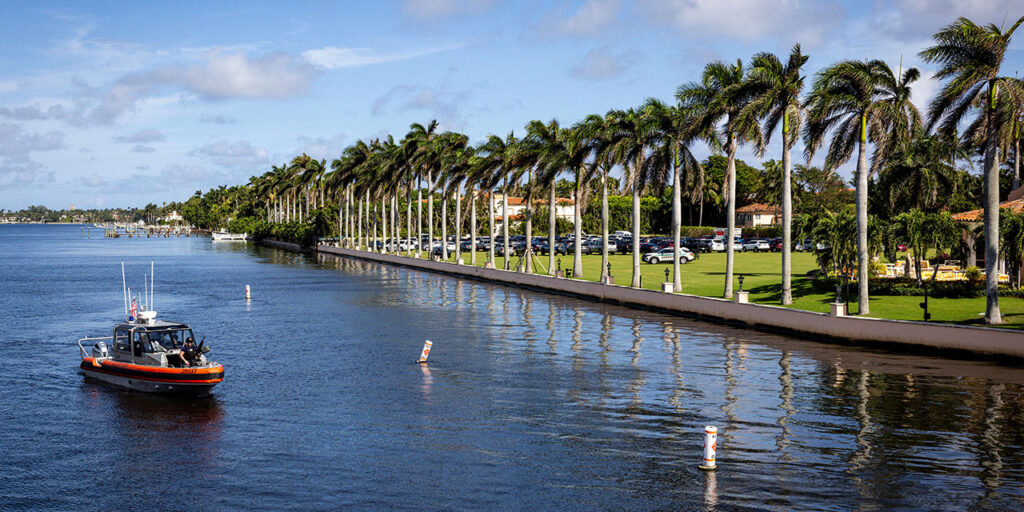When most people ask where Palm Beach residents go for the summer, they usually hear about the Hamptons—naturally so, since there has long been regular transit between the two posh destinations. With the permanent arrival of many New Yorkers in Palm Beach in recent years, the Island in season looks more and more like its northern resort analogue. New York restaurants and galleries have appeared, prices have soared, and traffic levels become maddening.
This summer, reports suggest the direction may be reversing, as Palm Beach establishments follow their clientele to the Hamptons, where the Colony Hotel and other Island brands are opening outposts. But before anyone answers a recent New York headline asking “Is the Hamptons Becoming Palm Beach?,” consider the resemblance between Palm Beach and the French Riviera—specifically, Saint-Jean-Cap Ferrat. Despite the distance in geography and culture, the two bear a striking resemblance. Both are small towns of just a few thousand residents, nestled on a few hundred acres of sun-drenched, high-priced coastline.
Finally, a reason to check your email.
Sign up for our free newsletter today.
Managing these resort communities depends on tact, though rules are carefully laid out and enforced. Palm Beach’s town council is famous for its volunteer committees, which have the power to approve or deny development, construction, and renovation projects. In early July, the town’s development review committee voted to approve billionaire hedge fund owner Ken Griffin’s request for a variance to put up a fence somewhat higher than the seven feet that town regulations normally allow. This follows the town’s much more spectacular 2006 contretemps with another billionaire resident, then-private citizen Donald J. Trump, who allegedly broke code by installing an 80-foot flagpole at Mar-a-Lago without clearance from the town, whose normal limit is 42 feet. After the town council fined Trump $1,250 per day for his tall American flag—an action for which the future president said it “should be ashamed of itself”—he sued the town for $25 million for violating his First Amendment free expression rights. A court-ordered mediation allowed Trump to install a 70-foot flagpole in exchange for a donation to a veterans’ organization and also amended rules on private clubs to allow nonresident members, a restriction to which Trump objected.
True, Saint-Jean-Cap-Ferrat sits on a peninsula, not a barrier island like Palm Beach. But with only narrow two-lane roads linking it to the mainland, it, too, feels like a world apart, with its manicured appearance and strict regulations, which are managed by its municipal council or, in some cases, an intercommunal syndicate created in 1964 to do so in tandem with nearby municipalities. As in Palm Beach, almost any project requires a permit, but here there must also be a publicly displayed placard indicating exactly what is being done, who is doing it, why it is being done, and how long it will take. One such placard on display outside a house this summer helpfully informed passersby when an exterminator would be doing his work inside.
Noise, however, is an even greater concern, and both towns impose strict restrictions on the hours and times of year when construction can be done. Saint-Jean-Cap-Ferrat generally prohibits it altogether in high season—the months of July and August—and during a two-hour lunchtime period the rest of the year. Palm Beach more modestly has prohibited all construction between Christmas Eve and New Year’s Day and has tried instituting daily schedules during the rest of the year, in addition to imposing detailed regulations that restrict the acceptable hours of “hooting” and “phonograph playing” to after 9 a.m.
Like Palm Beachers, les Saint-Jeannois, as they are known, prefer their privacy. Both communities feature stately properties ensconced behind high hedges and foreboding barriers. For over a century, the towns have attracted royalty, aristocrats, movie stars, business titans, hangers-on, and ne’er-do-wells. Both communities have statues to Winston Churchill, who spent time in the towns throughout his storied life, often painting their scenic views. Conservative politics are prevalent in both places. In November 2024, Trump, despite his earlier difficulties with the town, swept Palm Beach, winning 68 percent of its vote. In France’s most recent parliamentary elections, held earlier in 2024, Saint-Jean-Cap-Ferrat went for now-proscribed presidential candidate Marine Le Pen’s right-wing National Rally Party, at 62 percent.
Public life in both towns is built on discretion. Locals are polite but reserved with outsiders and never hesitate to point out property lines. Celebrities dine out, stroll through town, and dock their yachts (in recently expanded marinas) without being gawked at or accosted. Moral judgment is rare, but proper behavior is enforced more strictly than elsewhere.
Both towns are notably free of litter. In France, free expression does not extend to dress, and Saint-Jean-Cap-Ferrat prohibits shirtless bathing attire on town streets, with a 38-euro fine for violations. Palm Beachers have lobbied for a similar rule; barred from it by the First Amendment, they must rely on silent disapproval and old vagrancy laws inherited from the South.

Beyond such niceties, local eccentrics have always thrived—often flaunting the exotic. Legendary Palm Beach architect Addison Mizner kept a pet monkey, Johnnie Brown, as a constant companion. His Saint-Jeannoise contemporary, the Russian-Hungarian Princess Vilma Lwoff-Parlaghy, a celebrated portraitist and adventuress, famously walked her pet lion cub, Goldfleck, on a leash.
Tourism is not discouraged, but the glitziest visitors in both places are discreetly channeled to manicured resort hotels, located away from town centers and protected by security gates. In Palm Beach, the Breakers—a Renaissance Revival luxury palace built in 1896 and still family-owned—opened before the town itself existed. Its counterpart, the style moderne Grand-Hôtel du Cap-Ferrat, now a Four Seasons, rose just 12 years later at the remote tip of the peninsula. Seasonal rates at both can reach four figures per night.
History matters in both Saint-Jean-Cap-Ferrat and Palm Beach. The hamlet of Saint-Jean got its start as a modest fishing village within the municipality of nearby Villefranche, with the neighboring Cap Ferrat promontory boasting a wilder history of Christian hermits, Muslim pirates, and defensive forts.
Palm Beach was home to Native Americans until a handful of settlers established land claims. The Island’s iconic royal palms arrived courtesy of a wrecked Spanish ship carrying cocoanuts. Saint-Jean-Cap-Ferrat, reportedly down to its last fisherman, maintains proud monuments to its commercial past, while Palm Beach is inscribed with tales of its early settlement.
Later eras contributed a museum-like ambiance to both communities. The Gilded Age left its mark, with similarly extravagant homes rising at the whim of proprietors drawn by new rail connections to the metropolitan north. Each community has many extant samples that remain in private ownership, but also one overarching palace of the Beaux-Arts era that survives as a revered local museum for the public.
For Palm Beachers, that institution is Whitehall, now the Henry M. Flagler Memorial Museum, which Flagler, whose late-life efforts developed the town, completed as a present for his third wife in 1902. Saint-Jeannois lavish attention on the equally well-preserved Villa Ephrussi de Rothschild, finished just ten years later, on commission from the banking heiress Béatrice de Rothschild after she won a legal separation from her rakish and heavily indebted husband.
One crucial difference remains. The pandemic rush on Palm Beach seems to have spared Saint-Jean-Cap-Ferrat, with Riviera tourism now focused on Saint-Tropez. A joke circulating in some circles now says “Saint-Tropez” is the French word for “Brickell,” Miami’s recently redeveloped downtown quarter. How long Saint-Jean-Cap Ferrat will enjoy its tranquility, however, could depend on how long New Yorkers can stand the Hamptons. But I have little fear.
Top Photo: St-Jean-Cap-Ferrat’s rocky coast, near Nice (Jumping Rocks/Universal Images Group via Getty Images)
Source link


















